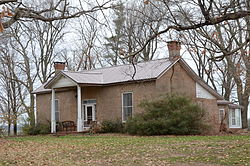Bell House or Bellhouse may refer to:
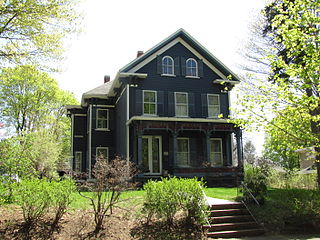
15 Wave Avenue is a well-preserved Italianate style house in Wakefield, Massachusetts. It was built between 1875 and 1883, and was listed on the National Register of Historic Places on July 6, 1989.

Williston Congregational Church is a historic church in the center of Williston Village on United States Route 2 in Williston, Vermont. Built in 1832 and the interior restyled in 1860, this brick church is a fine local example of Gothic Revival architecture. It was listed on the National Register of Historic Places in 1973.

The Borden House is a historic house on the grounds of Prairie Grove Battlefield State Park in Prairie Grove, Arkansas. In the Battle of Prairie Grove on December 7, 1862, the original Borden House was one of the central points of the Confederate line, and was the scene of heavy casualties. The Borden House was burned the next day. Archibald Borden built the current house on the original site. It is a 1+1⁄2-story wood-frame house, five bays wide, with a side-gable roof pierced by three gabled dormers. A porch extends across the center three bays of the front.

The Carlton House is a historic house located at 434 South Lakeshore Drive in Lake Village, Arkansas.
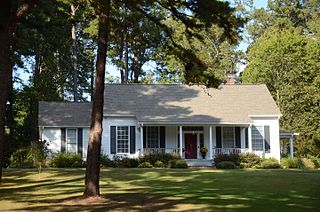
The Richmond-Tufts House is a historic house in rural Ouachita County, Arkansas, outside the county seat of Camden. This single-story wood-frame house was built in 1853, and was originally located on West Washington Street in Camden, before being moved to its present location c. 1961. When first built, the house had Greek Revival styling, but it was extensively renovated and extended after its purchase in 1883 by Alfred Tufts, a Northern carpetbagger who moved to Camden after the American Civil War, married a local woman, and acquired a great deal of land. He made numerous Late Victorian additions to the house, most of which were undone when the house was moved, restoring its original Greek Revival character. The house is five bays wide, with a side gable roof, and a four-column porch that extends across a portion of the front.
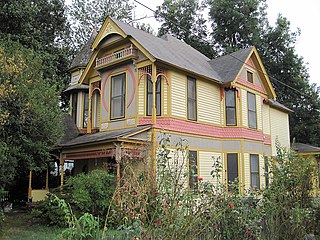
The Bell House is a historic house at 303 West Cherry Street in Jonesboro, Arkansas. It is a two-story wood-frame structure, built in 1895 by J. V. Bell, owner of one of Jonesboro's first bookstores. The house is an elaborately-decorated Queen Anne Victorian, with an asymmetrical arrangement of projecting bays, gables, and porches. The front porch has a delicate spindle-work frieze, and is supported by turned columns. Different types of cut shingles give variety to the wall surfaces.
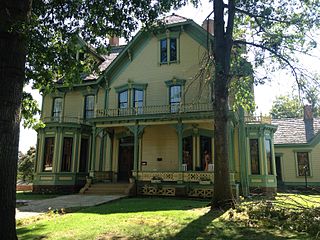
The W.H.H. Clayton House, now the Clayton House Museum, is a historic house museum at 514 North 6th Street in Fort Smith, Arkansas. It is a 2+1⁄2-story L-shaped wood-frame structure, with a projecting front clipped-gable section. It has elaborate Victorian trim, including detailed window surrounds, paneled projecting bays on the front and side, and a porch with carved columns and brackets, and delicately turned balusters ringing the porch roof. The house was built in 1882 for W. H. H. Clayton, who served as a local prosecutor and was member of family prominent in state politics, and is one of the few high-quality houses of the period to survive. It is now a museum.

The Tom Smith House is a historic house on Arkansas Highway 74, east of Elkins, Arkansas in Washington County. It is a single-story brick structure, with a side gable roof, end chimneys, and a four-bay front facade. The bricks, which were locally made, are four courses deep, and end in a cornice shaped out of S-shaped molded bricks, an extremely rare detail. The front facade is asymmetrically arranged, with two doors in the center bays and sash windows in the outer bays. Built c. 1834, it is a rare regional example of late Georgian architecture, and is historically significant for its builder, Thomas Smith, who was one of the earliest white settlers of the area. The house stands behind a more recent frame house on more than 30 acres (12 ha) of land on the north side of AR 74.

The Peter Smyth House is a historic house at 1629 Crossover Street in Fayetteville, Arkansas. Built in 1886, it is a regionally rare example of a small stone cottage built in a traditional central hall plan. The house is built out of coursed sandstone, and has finely-chiseled lintels and sills for the openings. The front facade is five bays wide, with a center entry flanked by four sash windows. There two chimneys just inside the outer side walls at the peak of the side gable roof. A stone ell of antiquity similar to that of the house is attached to the rear; it is uncertain whether it was built as an integral part of the house, or added later.

The Drennen-Scott House is a historic house museum on North 3rd Street in Van Buren, Arkansas. It is a single-story log structure, finished in clapboards, with a side-gable roof that has a slight bell-cast shape due to the projection of the roof over the front porch that extends across the width of its main block. The house was built in 1836 by John Drennen, one of Van Buren's first settlers. Drennen and his brother-in-law David Thompson were responsible for platting the town, and Drennen was politically active, serving in the territorial and state legislatures, and at the state constitutional convention. The house remained in the hands of Drennen descendants until it was acquired by the University of Arkansas at Fort Smith, which operates it as a house museum.

The Wade-Heerwagen House is a historic house at 338 North Washington Avenue. in Fayetteville, Arkansas. It is a two-story wood-frame structure, built in the 1870s in imitation of pre-Civil War houses more typical of late-18th century Virginia. The house is T-shaped, with a front section three bays wide that has a two-story porch extending across its width, and a rear ell added after the house's initial construction. Its interior includes the first bathtub installed in Fayetteville.
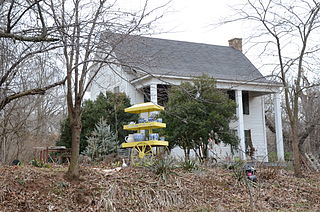
The Moore House is a historic house on Washington County Road 13 northwest of Canehill, Arkansas. It is a two-story wood-frame house, three bays wide, with a side gable roof, clapboard siding, and a shed-roof porch extending across the front. The first floor of the house was built in 1856, with the second following in 1896; a kitchen ell was added to the rear in 1893. The property also includes the remains of an early log structure, probably a granary.

The Tharp House is a historic house at 15 North West Avenue in Fayetteville, Arkansas. It is a 1+1⁄2-story wood-frame house, with Queen Anne styling. Its front facade is three bays wide, with a projecting square gable-roofed section to the right, and the main entrance in the center, sheltered by a porch that wraps around the left side. A large gabled dormer projects from the hip roof above the entrance, large enough for a doorway and a small balcony. Built in 1904 by Moses Tharp, it is an unusual local example of late Queen Anne style.

The John Tilley House is a historic house in rural Washington County, Arkansas, United States. It is located on the south side of Stonewall Road, west of Prairie Grove, and is one of the county's few rural antebellum brick houses. In fact, it is one of only 24 antebellum houses in Arkansas deemed sufficiently "original" for inclusion on the National Register.
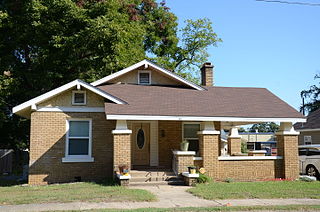
The Bell House is a historic house at 302 West Woodruff Avenue in Searcy, Arkansas. It is a single-story brick structure, with an irregular roofline. A porch, headed by a side gable entrance projects to the right, continuing across the front to meet a small front-gable projecting in front of a higher front-facing gable roof. The porch is supported by high brick piers topped by short wooden posts. Built in 1915, it is a fine local example of Craftsman architecture.
The Chandler House is a historic house in rural northern White County, Arkansas. It is located just north of the junction of Stanley and Honeysuckle Roads, northwest of Bald Knob. It is a two-story wood-frame structure, with weatherboard siding and a gable roof. A hip-roofed porch extends around its front to the side, supported by square posts, and a shed-roof addition extends to the rear. The front is symmetrically arranged, three bays wide, with sash windows on either side of the entrance, and a third window in the gable above. The house was built about 1885, and is probably one of the first gable-entry houses to be built in White County, and one of a very few to survive from the 19th century.

The Thomas E. Hess House is a historic house on Arkansas Highway 14 in Marcella, Arkansas. It is a two-story I-house, five bays wide, with a side gable roof, weatherboard siding, and stone foundation. A two-story porch extends across the middle three bays of the north-facing front facade, with some jigsaw decorative work and turned balusters. An ell extends to the rear, and the rear porch has been enclosed. The house was built in 1900 by Thomas E. Hess, grandson of William Hess, the area's first white settler. Other buildings on the property include a barn, stone cellar, and a log corn crib that was originally built as a schoolhouse.
The Ellis Building is a historic commercial building at 208 North Block Avenue in Fayetteville, Arkansas. It is a single-story brick building, with a hip roof that has a rounded top section. The roof's shape is obscured from the front by a low stepped parapet. The front facade has a former garage bay opening to the left, and a pair of plate glass display windows flanking a pedestrian entrance to the right. The building was under construction about 1923, and is one of the oldest surviving automotive service buildings in northwestern Arkansas. It has housed a variety of commercial businesses since ending automotive use about 1955.
